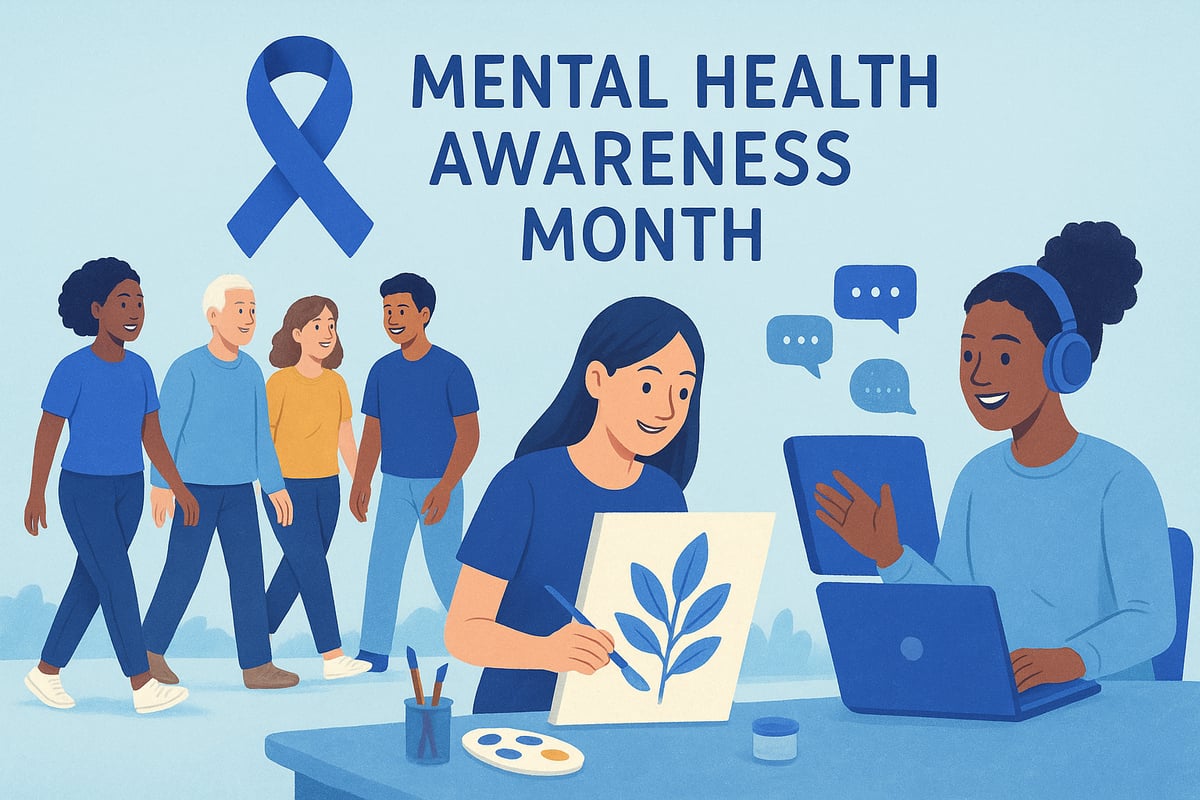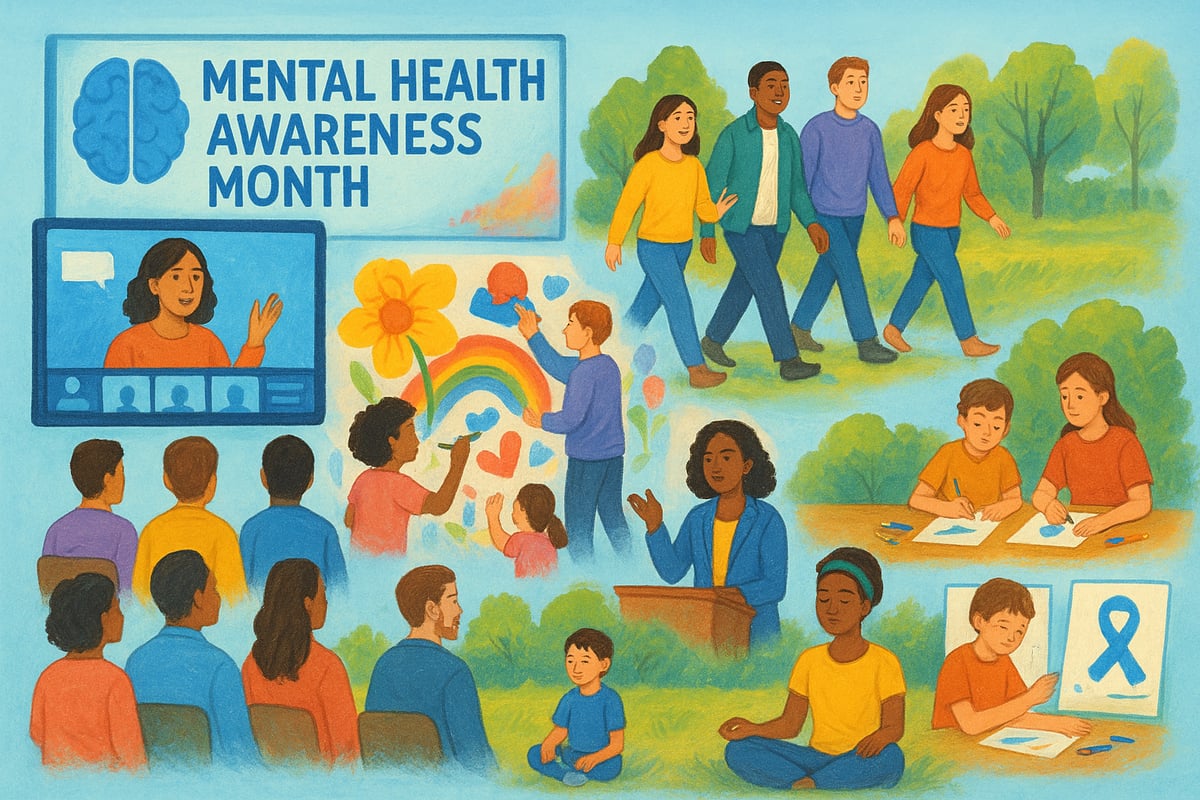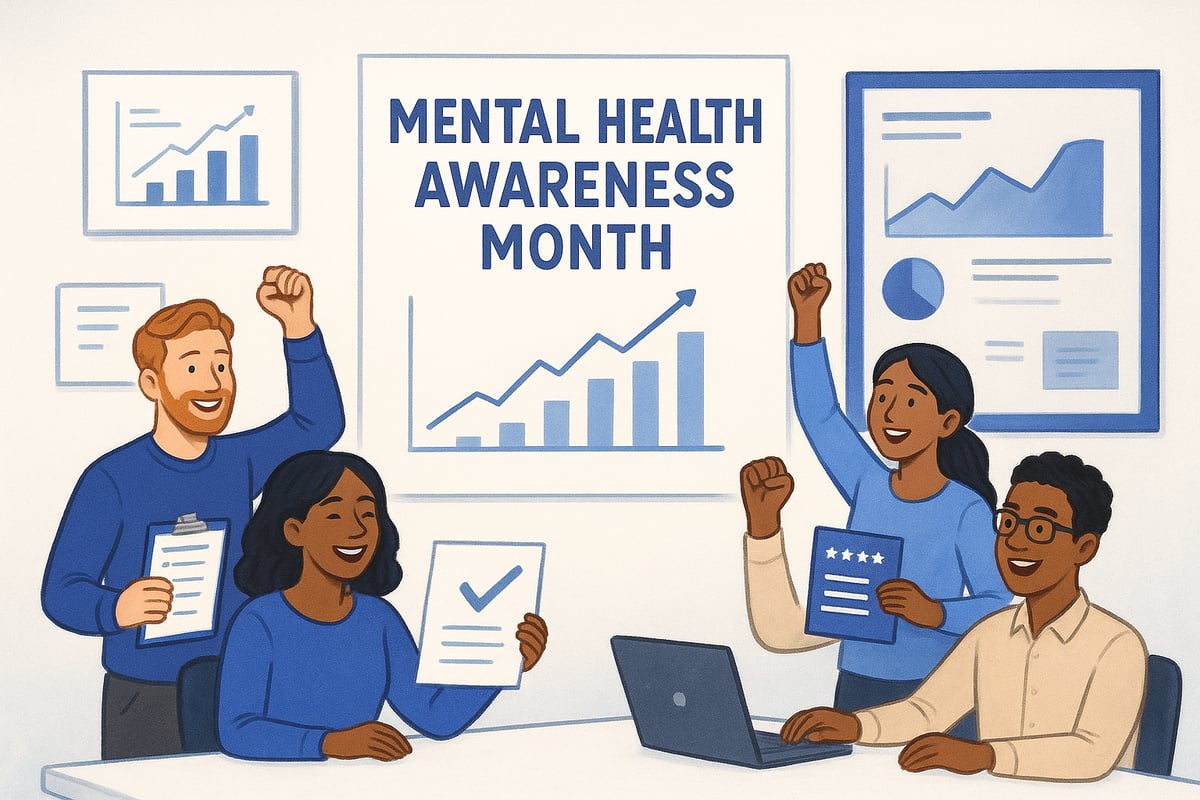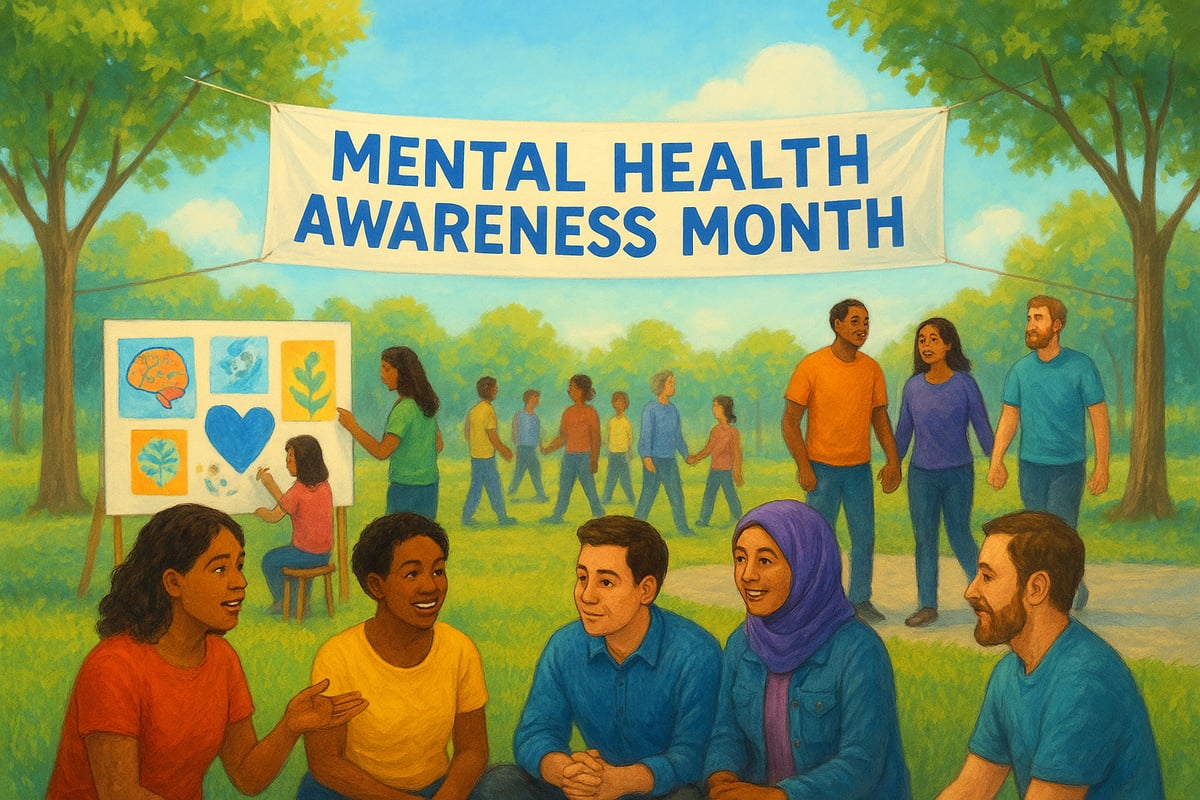Mental health is in the spotlight like never before as we head into 2025. More people are recognizing the need to support well-being across every aspect of daily life. Mental Health Awareness Month is the perfect chance for individuals, workplaces, and communities to come together and make a positive difference.
This article will guide you through 9 inspiring and practical mental health awareness month activities for 2025. Whether you are looking for ideas to try on your own, at work, or in your community, you will find actionable strategies that spark real change.
Get ready to discover new ways to boost mental health, break down stigma, and inspire lasting action.
The Importance of Mental Health Awareness Month
Mental Health Awareness Month began in the United States in 1949, born from the need to address mental health stigma and educate the public. Over the decades, this observance has grown in reach and relevance, inspiring global communities to prioritize mental wellbeing. Today, mental health awareness month activities are recognized as vital stepping stones for change, not only in the US but across the world.
In 2025, the conversation around mental health is more critical than ever. The aftermath of the global pandemic has shifted how individuals and organizations view mental health. People are more open about their struggles, and the demand for supportive environments is at an all-time high. According to recent studies, one in four adults will experience a mental health issue each year, highlighting the urgent need for accessible mental health awareness month activities.
The impact of stigma remains a significant barrier. Many people hesitate to seek help due to misconceptions about mental illness. A 2024 survey found that nearly 60% of individuals with mental health challenges avoid treatment because of fear or shame. This is why mental health awareness month activities play a crucial role in breaking down barriers. By encouraging open dialogue and education, these initiatives foster understanding and compassion.
Awareness months also drive early intervention and prevention. For example, past campaigns have showcased the effectiveness of peer support programs and resource fairs. Schools introducing mental health awareness month activities have reported increased student engagement and reduced absenteeism. Workplaces that participate often see better morale and productivity. Communities benefit from a stronger sense of connection and support.
Below is a summary table of recent statistics:
| Area | Statistic (2024-2025) |
|---|---|
| Global Prevalence | 1 in 4 adults experience challenges |
| Stigma Impact | 60% avoid treatment due to stigma |
| Youth Trends | 30% of teens report persistent sadness |
| Workplace ROI | $4 return for every $1 invested |
Despite the progress, misconceptions persist. Some believe mental health awareness month activities are only symbolic, yet research shows they spark real, measurable change. Past successful campaigns, like community walks and art initiatives, have led to increased help-seeking behavior and policy improvements.
Diverse groups benefit in unique ways. Schools build resilience in students, workplaces cultivate supportive cultures, and communities strengthen social bonds. However, barriers such as limited resources or lack of knowledge can hinder participation. Comprehensive resources, such as the Mental Health Awareness Month 2025 Toolkit, empower organizers to plan effective mental health awareness month activities tailored to their audience.
Ultimately, awareness months are catalysts for long-term change. They help set the stage for ongoing conversations, policy development, and cultural shifts. When individuals, workplaces, and communities come together to support mental health awareness month activities, they lay the foundation for a healthier, more inclusive future.

9 Inspiring Mental Health Awareness Month Activities for 2025
Mental health awareness month activities in 2025 offer unique ways to foster understanding, connection, and support. Whether you are an individual, an organization, or part of a community, these nine activities are designed to inspire positive change and lasting impact. Explore practical steps, real-world examples, and expert tips to make your mental health awareness month activities both meaningful and memorable.

1. [Host a Virtual Mental Health Workshop]
Hosting a virtual workshop is one of the most effective mental health awareness month activities for 2025. Begin by defining your workshop’s goals—do you want to promote stress management, mindfulness, or self-care? Choose topics relevant to your audience, such as resilience or coping strategies.
Next, collaborate with mental health professionals or qualified speakers to ensure credible, engaging content. Platforms like Zoom, Microsoft Teams, or Google Meet make it easy to connect with participants anywhere. Encourage interaction through live Q&A, polls, and breakout sessions.
To maximize participation, promote your workshop in advance and offer flexible scheduling. Share digital resources and follow-up materials to extend the workshop’s impact.
Many organizations have found success with virtual events, reporting higher attendance and increased accessibility compared to in-person sessions. For more inspiration and detailed planning tips, visit the Mental Health Month Activities Guide.
Virtual workshops not only raise awareness but also create inclusive spaces for learning and support, making them a standout choice among mental health awareness month activities.
2. [Organize a Community Wellness Walk]
A wellness walk is a simple yet powerful way to bring people together for mental health awareness month activities. Start by selecting a safe, accessible route in your community. Collaborate with local businesses or organizations for sponsorship and support.
Physical activity is proven to boost mood, reduce anxiety, and foster social connection. To enrich the experience, set up educational stations along the route. Invite guest speakers to share tips on mental health and wellness.
Ensure the event is inclusive by providing options for all ages and abilities. Offer water stations, rest areas, and clear signage. Promote the walk through flyers, social media, and community partners.
Communities that host wellness walks often see increased engagement and improved mental health outcomes. By combining movement with education, this activity becomes a cornerstone of mental health awareness month activities.
3. [Implement a Workplace Mental Health Challenge]
Workplace challenges are engaging mental health awareness month activities that unite teams and promote wellbeing. Design a month-long challenge that includes daily gratitude journaling, mindfulness breaks, or kindness initiatives.
Encourage participation by tracking progress and celebrating achievements. Use digital platforms to share updates and highlight success stories. Leadership involvement is key—when managers participate, it signals organizational commitment to mental health.
Companies with robust mental health challenges report stronger team cohesion, reduced stress, and higher job satisfaction. To ensure inclusivity, offer flexible activities and recognize diverse contributions.
Tracking participation and gathering feedback help refine future initiatives. These challenges are a practical way to embed mental health awareness month activities into workplace culture.
4. [Create an Art for Awareness Campaign]
Art campaigns are creative mental health awareness month activities that foster expression and dialogue. Organize art contests, mural projects, or digital galleries to encourage participation from all ages.
Partner with local artists, schools, or community centers to broaden reach. Display artwork in public spaces or online, and invite viewers to reflect on mental health themes.
Art breaks down barriers and reduces stigma, making it easier for people to share their experiences. Promote submissions through newsletters, social media, and community events.
Successful campaigns often feature diverse voices and powerful visuals, sparking conversations that extend beyond mental health awareness month activities. Data shows that art therapy and creative engagement can improve mental health outcomes for participants.
5. [Facilitate Storytelling and Lived Experience Panels]
Storytelling panels are transformative mental health awareness month activities that build empathy and understanding. Organize events where individuals share their mental health journeys in a safe, supportive environment.
Establish clear guidelines to protect speakers’ privacy and emotional wellbeing. Recruit a diverse group of participants to reflect different backgrounds and experiences.
Personal stories have a profound impact, helping to combat stigma and inspire others to seek help. Facilitate audience questions and discussion to deepen engagement.
Research shows that hearing lived experiences shifts attitudes and increases willingness to support mental health initiatives. These panels make mental health awareness month activities personal and powerful.
6. [Launch a Mental Health Resource Fair]
Resource fairs are dynamic mental health awareness month activities, offering direct access to information and support. Plan your fair in-person or online, inviting local providers, support groups, and advocacy organizations.
Curate a range of resources, from brochures and toolkits to live workshops and helplines. Make the fair interactive with Q&A sessions and hands-on demonstrations.
Promote the event widely to maximize attendance. After the fair, collect feedback to assess impact and identify gaps in resources.
Communities that host resource fairs often see increased help-seeking behavior and greater awareness of local services. These fairs are a practical foundation for mental health awareness month activities.
7. [Promote Mindfulness and Meditation Sessions]
Guided mindfulness and meditation sessions are impactful mental health awareness month activities for stress reduction and emotional regulation. Organize regular sessions in-person or online, led by qualified instructors or using trusted digital resources.
Schedule sessions at convenient times for your audience, whether in workplaces, schools, or community centers. Encourage consistent participation by integrating mindfulness into daily routines.
Evidence shows that regular mindfulness practice can lower stress, improve focus, and enhance emotional wellbeing. Organizations that adopt these sessions report positive shifts in morale and resilience.
Mindfulness sessions are flexible, accessible, and effective, making them a valuable part of mental health awareness month activities.
8. [Engage Youth with Mental Health Education Initiatives]
Youth-focused mental health awareness month activities lay the foundation for lifelong wellbeing. Plan age-appropriate workshops, assemblies, or peer support programs in schools.
Collaborate with educators, parents, and youth leaders to design engaging content. Creative approaches include mental health days, awareness campaigns, and student-led initiatives.
Early intervention and mental health literacy are critical for prevention. Case studies reveal that schools with strong mental health programs see better academic and social outcomes.
Empowering youth through education ensures the next generation is equipped to support themselves and others during mental health awareness month activities and beyond.
9. [Use Social Media for Digital Awareness Campaigns]
Social media campaigns are modern mental health awareness month activities with vast reach. Develop impactful campaigns using hashtags, challenges, and infographics to spread key messages.
Partner with influencers and mental health advocates to amplify your campaign. Tailor content to resonate with diverse audiences and measure success through engagement metrics.
Highlight responsible messaging and online safety to foster positive digital spaces. Viral campaigns can drive real-world change and encourage participation in mental health awareness month activities.
Social media’s influence continues to grow, making it an essential tool for raising awareness, reducing stigma, and connecting communities.
How to Measure Impact and Sustain Momentum After Mental Health Awareness Month
Measuring the success of mental health awareness month activities is essential for driving lasting change. Tracking impact not only validates your efforts but also helps refine future initiatives and secure ongoing support. By using effective measurement strategies, organizations and communities can maximize the benefits of their mental health awareness month activities and keep the momentum going well beyond May.

Track Participation and Engagement
Start by recording attendance at events, workshop sign-ups, and social media interactions. Use registration forms, sign-in sheets, or digital analytics tools to gather data. Monitoring participation rates in mental health awareness month activities provides insight into what resonates with your audience.
Surveys and quick polls during or after events can capture real-time engagement. Tools like Google Forms or SurveyMonkey make it easy to collect and analyze responses. Engaged participants are more likely to benefit and share their experiences, expanding the reach of your mental health awareness month activities.
Gather Feedback and Testimonials
Collecting feedback is vital for understanding the impact of your mental health awareness month activities. Ask participants to share their thoughts through anonymous surveys, suggestion boxes, or structured interviews. Testimonials, whether written or recorded, add a personal touch and can be powerful in encouraging future involvement.
Encourage honest, constructive feedback by ensuring confidentiality and expressing appreciation for participants’ input. Use this feedback to identify strengths, areas for improvement, and new ideas for next year’s mental health awareness month activities.
Set Measurable Goals and KPIs
Establish clear objectives before launching your mental health awareness month activities. Common KPIs include attendance numbers, social media reach, participant satisfaction scores, and increases in help-seeking behavior. Creating a table to compare baseline data with post-event outcomes can highlight progress and areas for growth.
| Metric | Baseline | Post-Event | Change |
|---|---|---|---|
| Event Attendance | 50 | 120 | +140% |
| Social Media Shares | 200 | 600 | +200% |
| Feedback Score (avg.) | 3.5/5 | 4.6/5 | +1.1 points |
Tracking these KPIs demonstrates the tangible value of your mental health awareness month activities to stakeholders.
Sustain Momentum and Integrate for Long-Term Impact
To keep the spirit of mental health awareness month activities alive, plan follow-up events, regular check-ins, or year-round initiatives. Share success stories and data-driven outcomes with your community or team to maintain enthusiasm. Consider integrating mental health activities into ongoing routines, such as monthly mindfulness sessions or quarterly wellness challenges.
Leverage insights from campaigns like Mental Health Awareness Month 2025: Turn Awareness Into Action to shift from awareness to ongoing advocacy and support. Sustained engagement leads to deeper cultural change, reducing stigma and promoting well-being over time.
Report Results and Celebrate Successes
Summarize key achievements in reports or infographics and share them widely. Celebrate milestones with your team or community, recognizing individual contributions and collective progress. Highlighting the positive outcomes of mental health awareness month activities inspires continued participation and demonstrates your commitment to long-term mental health.
By measuring impact, gathering feedback, and sustaining momentum, your mental health awareness month activities can drive real, lasting change for individuals, workplaces, and communities.
Mental Health Awareness
Mental Health Awareness is at the heart of creating positive change in how we approach mental wellbeing. This category features resources, tools, and inspiration for those seeking to promote mental health awareness month activities in 2025 and beyond. If you are looking to align your initiatives with national observances, the Mental Health America Awareness Calendar 2025 is an excellent starting point for planning impactful events and programs.

As you explore these nine inspiring activities for Mental Health Awareness Month 2025, you’ll see how small, practical steps can create lasting change—whether you’re empowering your team at work, connecting with your community, or supporting friends and family. If you’d like to dive deeper into tailored mental health training or discover more ways to build resilience and wellbeing in your workplace, we’re here to help. Let’s create a culture where mental health truly matters—one positive action at a time.
Find Out More


